As an aquarium owner, having the right tank is hugely important when building a fish community. Something that is equally as important as having the right tank and fish is making sure that their surroundings are suitable for them to live a happy and healthy life.
Coral is one of the most essential inclusions to any saltwater reef tank. If you have or are planning on owning several saltwater fish, crabs, or other marine species, it is a must to have some coral accompanying them.
The inclusion of coral species creates a balanced and healthy fish tank and subsequent environment. There are many species of fish that have special relationships with corals and benefit tremendously by having their presence in their home.
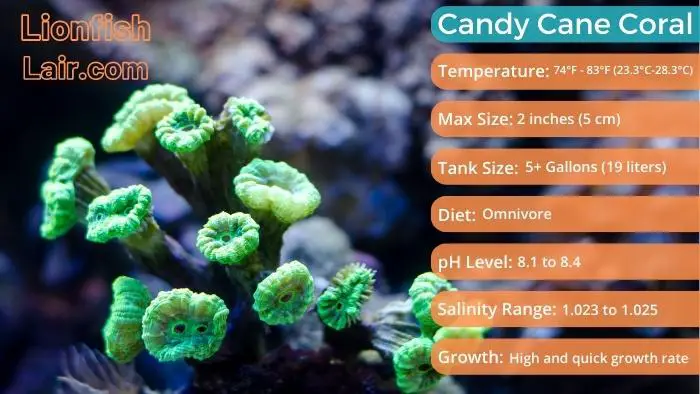
Candy Cane Coral Quick Summary
Here is a brief overview of the candy cane coral:
- Scientific name: Caulastraea furcata.
- Other names: Candy cane coral, trumpet coral, and bullseye coral.
- Care level: Easy/Beginner compatible.
- Behavior: Peaceful.
- Natural habitat: Typically found in sheltered, shallow water with sandy substrate.
- Other coral compatibility: They are more than compatible with other coral species, especially other Euphyllia species.
- Temperature range: 74-83°F (23.3-28.3°C).
- Salinity: 1.023 to 1.025.
- pH level: 8.1 to 8.4.
- Minimum tank size: Compatible with nano aquariums up to large reef tanks!
- Aquarium lighting: Low to moderate lighting is required for these corals.
- Water flow: Low to moderate water flow is also required.
- Diet & feeding: You should feed them small, meaty zoo-plankton foods or similar, but do so when the feeding polyps have been extended.
- Supplements: You want to be adding calcium in addition to their regular diet, >400 ppm will suffice.
Appearance
For most hobbyists, aesthetics is key, and coral does not get more aesthetically pleasing than Candy Cane.
The Caulastrea Furcata Candy Cane Coral is an LPS coral. LPS coral is a specific coral species that has a stony, skeleton like body and is made from calcium carbonate, and large fleshy polyps.
The additional names given to the Candy Cane are Trumpet, Torch, Candy, and Bullseye Coral. The “Candy” name is derived from their striped appearance on their polyps.
Candy Coral is considered by many to be one of the easier corals to keep, and perfect for hobbyists starting out or being introduced to the LPS family of corals within their saltwater aquarium.
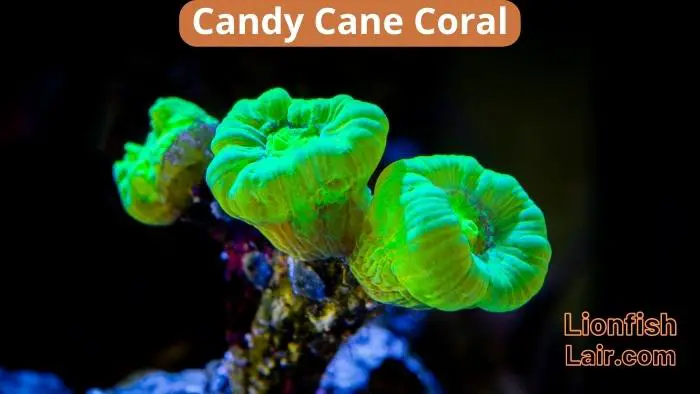
The Candy Cane can come in several different colors: green, yellow, or blue and brown. Under a blue light, you can really see their vibrant glow lighting up the tank and subsequently making for a beautiful addition to the community.
Behavior
The coral itself is hardy and peaceful by nature, with short sweeper tentacles. You should be feeding them additional food on a weekly basis, some of these include brine shrimp or micro-plankton.
The lighting should be moderate, and they thrive under moderate water movement too. It is also recommended that Candy Cane Coral is placed in water that has calcium, strontium, and other small elements.
Candy Cane Coral Requirements
Here is a checklist consisting of all you need to know about Candy Corals, from dos and don’ts to food and predators:
- The birthplace of Candy Cane Coral is Tonga, and despite being away from a lot of places geographically, they are relatively easy to acquire and will be found in most fish shops.
- As mentioned previously, they are an LPS coral species.
- These Candy Canes are perfect beginner corals for hobbyists at any level.
- The known predators of the Candy Cane Coral are Pufferfish, Triggerfish, and other pesky fish that either eat or enjoy destroying coral reef.
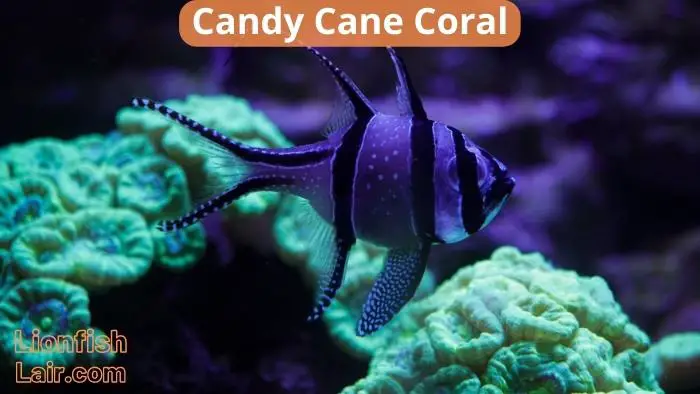
Despite being relatively peaceful by nature, they have been sometimes known to have slightly aggressive tendencies when situated in close proximity to other corals, using their sweeper tentacles to sting others.
However, their sweeping tentacles are incredibly short and could only really affect corals that are located within extremely close proximity to them.
Lighting
The lighting must be medium to high for Caulastrea Furcata to flourish. The water flow must be medium to strong, and the placement should be low to medium.
They require light for energy, as this type of coral have zooxanthellae, which allows for energy to be gathered by light.
Also, in addition to the right environment, regularly feeding them is beneficial, and also spot feeding is recommended.
Tank Placement
These coral species tend to perform best when they are placed in areas with moderate flow and moderate lighting accompanying it.
Although, they can be acclimated to accept lower or higher levels of lighting and flow, but it isn’t really recommended.
They do the best when placed lower down in your saltwater fish tank, typically on sandy substrate. It is also best to keep them away from the direct lighting as they prefer medium to lower levels of lighting.
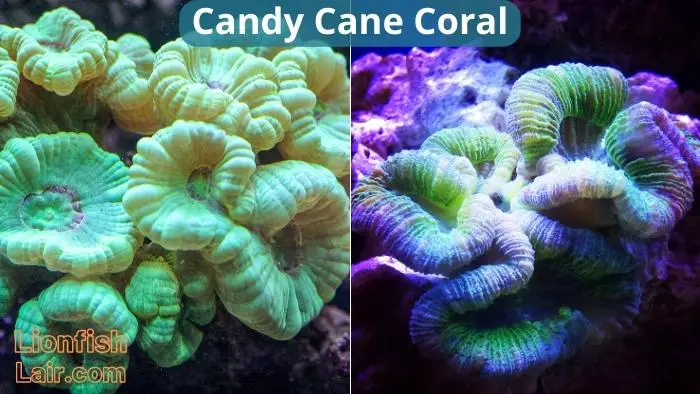
The location of your candy cane coral can actually effect the coloration of the coral, so, make sure you find the right placement for yours.
Growth Speed
The glorious array of colors they can come in are green, yellow, blue, and brown. Their growth speed is slow to medium.
If your tank has standard saltwater parameters, this coral should thrive, large parameter swings can be detrimental, and they also require a stable environment.
Food And Feeding Habits
Candy Cane Corals will grow faster and grow more vibrant colors if they are fed well and correctly.
Just because they aren’t as mobile as fish, Candy Cane Corals consume an awful lot of food so you must be diligent in regularly feeding them and making sure to spot feed them if they are not getting enough of a particular food.
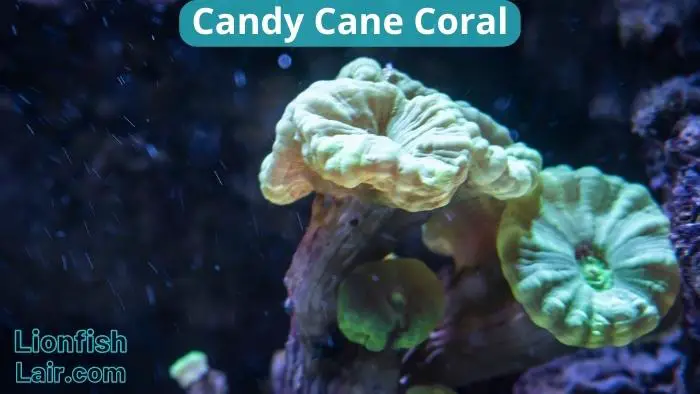
Here are the foods accepted by these corals:
- Specialist coral foods such as plankton
- Pellets
- Powdered coral food
- Meaty foods, such as shrimp, prawns & little bits of fish
- Copepods & Amphipods
- General fish foods such as flake & marine pellets
When it comes to the process of feeding Candy Cane Corals, there are many advisories, people believe that while you are feeding the rest of your tank, just simply add in more of the same fish food, and your candy corals will feed on the left-over nutrients.
However, other people have said that feeding more to the corals will just result in the same food intake for them and more for the rest of your community.
From experience, if you have good enough flow within your tank, sticking to the normal feeding cycle, including quantity is the best way to go about feeding them.
The nutrients will get to them eventually and you will have a happy and healthy coral as long as the general aquarium population are being fed items from the list above on a regular basis.
Conclusion
So, in conclusion, these Caulastrea Furcata are awesome additions to any tank that can accommodate them, and highly recommended for beginners or expert hobbyists.
You should start them off in a low flow, shady area of your tank, and then after a while start to slowly move them up to the recommended (medium level) location within your tank after several weeks.
If you start to notice your Candy Cane polyps retreating, you need to move them back down lower in your tank.
Apart from the fish we mentioned above, and notorious coral disturbing species, the Candy Cane Coral compliments most fish, and vice-versa, especially those with contrasting colors!
